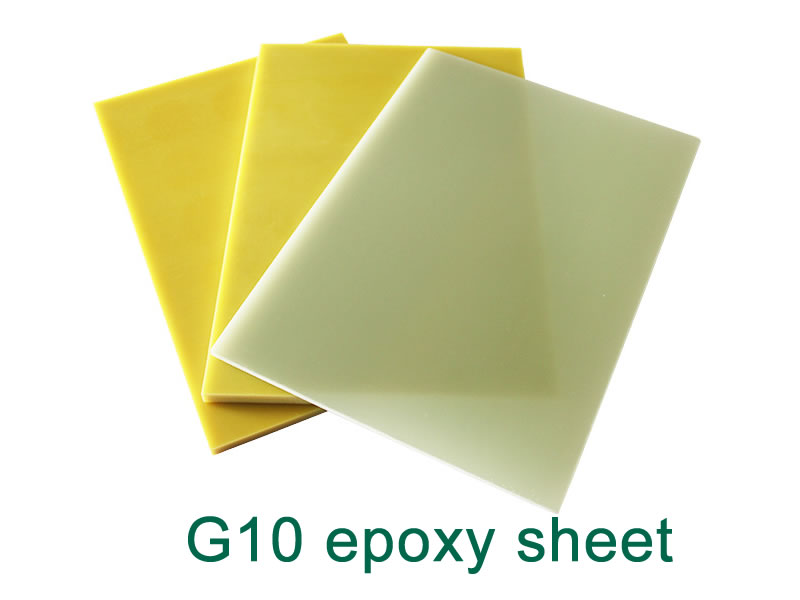G10 is a composite material made of fiberglass cloth and epoxy resin laminated under high temperature and pressure, w...
G10 is a composite material made of fiberglass cloth and epoxy resin laminated under high temperature and pressure, while FR4 is a flame-retardant epoxy fiberglass laminate that meets NEMA standards. The “FR” in FR4 stands for flame retardant, which meets the UL94V-0 standard, while G10 usually does not add flame retardants, so the flame retardant performance is poor.
Next, I need to compare their ingredients. G10 and FR4 have similar main ingredients, both fiberglass cloth and epoxy resin, but flame retardants, such as brominated compounds, are added to FR4 to improve flame retardancy. G10 may not have these additives, so its flame retardancy is not as good as FR4.

| Property | G10 | FR4 | Key Differences |
|---|---|---|---|
| Flame Resistance | UL94 V-1 or non-rated | UL94 V-0 (extinguishes ≤10 seconds) | FR4 releases halogen gas when burned. |
| Glass Transition Temp (Tg) | ~130°C | Standard: 130–140°C High-Tg: 170–180°C |
High-Tg FR4 suits lead-free soldering. |
| Dielectric Constant (Dk) | 4.3–4.9 (1 MHz) | 4.3–4.9 (1 MHz) | Both drop to ~3.8–4.2 at high frequencies (>1 GHz). |
| Dissipation Factor (Df) | 0.02–0.03 (1 MHz) | 0.02–0.03 (1 MHz) | High loss at >5 GHz (Df >0.05). |
| Flexural Strength | 415–483 MPa | 400–450 MPa | G10 has slightly higher mechanical strength. |
| CTE (Coeff. of Thermal Expansion) | Z-axis: 50–70 ppm/°C (below Tg) | Z-axis: 50–70 ppm/°C (standard) | Z-axis expansion spikes above Tg (>200 ppm/°C). |
| Moisture Absorption | 0.1–0.3% (24h immersion) | 0.1–0.3% (24h immersion) | Moisture degrades electrical performance. |
| Environmental Compliance | Typically halogen-free | Contains halogens (halogen-free options available) | Halogen-free FR4 meets RoHS but costs more. |
G10 Use Cases
Structural Components: Insulating spacers, mechanical supports, enclosures (non-flame-retardant scenarios).
Industrial: Transformer isolation plates, switchgear insulation.
Cost-Sensitive Projects: Non-electronic wear-resistant or corrosion-resistant parts.
FR4 Use Cases
PCB Substrates: Consumer electronics, computers, communication devices (90% of PCB market).
High-Temperature Environments: Automotive electronics (high-Tg FR4), power modules, LED drivers.
Flame-Retardant Requirements: Industrial controls, medical devices, aerospace electronics.
Unsuitable Applications
High-Frequency RF (>5 GHz): Use Rogers or PTFE materials instead.
Extreme Heat (>200°C): Requires polyimide (PI) or ceramic substrates.
Flexible Circuits: Use PET or polyimide films (e.g., Kapton).
| Process | Key Considerations |
|---|---|
| Cutting | – Tools: CNC mills, CO₂ lasers. – Parameters: Low speed, high feed to avoid resin carbonization. |
| Drilling | – Tools: Tungsten carbide or diamond-coated drills. – Cooling: Use compressed air to remove glass fiber dust. |
| Lamination | – Temperature: 170–180°C (adjust for FR4 Tg). – Pressure: 2–4 MPa to prevent delamination. |
| Etching (PCB) | – Chemicals: Ferric chloride or alkaline solutions. – Time control: Over-etching causes copper burrs. |
Common Issues & Solutions
Delamination:
Cause: High temperature or moisture absorption.
Fix: Preheat material (120°C, 2 hours); keep machining temps below Tg.
Tool Wear:
Cause: Abrasive glass fibers.
Fix: Use diamond-coated tools; reduce speed and increase cooling.
Edge Burrs (PCB):
Cause: Over-etching or mask misalignment.
Fix: Optimize etching time; use high-precision exposure equipment.
Surface Treatments
PCB Surfaces:
ENIG (Electroless Nickel Immersion Gold): Enhances solderability and oxidation resistance (higher cost).
HASL (Hot Air Solder Leveling): Cost-effective but uneven.
Structural Components:
Insulating coatings: Improve moisture resistance.
Polishing: Reduce fiberglass abrasion.
Selection Logic
Priority Order:1.Flame resistance → 2. Temperature → 3. Signal frequency → 4. Cost.
Examples:Automotive ECU: High-Tg halogen-free FR4 (heat resistance + RoHS compliance).Lab Insulation: G10 (low cost, no certifications needed)
Testing & Validation
Critical Tests:
Tg (TMA analysis), flame resistance (UL94), Dk/Df (vector network analyzer).
Reliability Tests:
Thermal cycling (-40°C to 150°C, 1000 cycles), humidity resistance (85°C/85% RH, 168h).
G10: Ideal for low-cost, non-flame-retardant, high-strength mechanical parts.
FR4: Industry-standard for electronics; balance flame resistance, thermal stability, and signal needs.
Machining Focus: Temperature control, dust management, and specialized tools to avoid delamination and tool wear.
By selecting the right material and following proper machining practices, G10/FR4 can meet most industrial and electronic requirements. For high-frequency or extreme environments, consider alternative materials like PTFE or polyimide.
If you are interested in our products,, please send us a message and we will contact you as soon as we receive it. Email: info@ztelecgroup.com whatsApp: +8616650273778